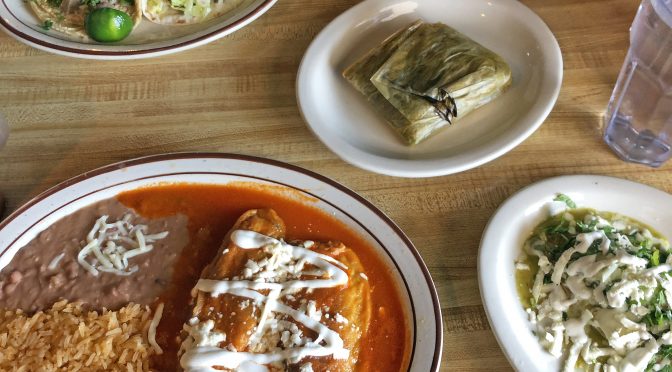By Robin Garr
LouisvilleHotBytes.com
¡Bueños días! Nihao! Konnichiwa! Bonjou! Xin Chào! Annyeonghaseyo! ? káàsán!
And there you have it! A simple, multilingual glossary to help bridge the language gap – let’s not call it a barrier – when you take your seat and greet the server at, respectively, a Latinx, Chinese, Japanese, Haitian, Chinese, Korean, or Nigerian restaurant.
There’s nothing quite like greeting a person in their own language to get your encounter off on the right foot, even if you don’t have much of a common language.
Indeed, for some of us, it’s exciting and fun to head for a taqueria out Preston Highway or an out-of-the-way South End Vietnamese eatery to order wonderful food from friendly people who may share only bits and pieces of a common language. For others, the idea of trying to communicate about unfamiliar food in an unknown language can by scary. And, let’s be honest: For most of us it’s a little bit of both: exciting fun and scary.
“I’m actually really intimidated by this,” a Facebook friend said during a conversation on this topic. “There are some spots that interest me but I feel like I may be intruding and slowing the process for others.”
For some, language-based misunderstandings aren’t just embarrassing but serious. “I’m allergic to dairy foods,” another friend explained. “I periodically learn the hard way that the person who took my order and told me something was dairy-free instead either misunderstood me or didn’t want to miss a sale.”
Spanglish in the kitchen
If you think that’s a challenge, take a peek into the kitchen of just about any local restaurant these days: Thanks to the growing Latinx diaspora, Spanglish is becoming a necessary form of communication for chefs and kitchen staff. According to the U.S. Bureau of Labor Statistics, 25.9% of restaurant industry workers in the U.S. were Hispanic or Latino in 2018, and the number continues to grow.
“Working in back of the house doesn’t require fluent English. So as long as you can take directions and cook or clean, you can make a living and build a career as you rise through the ranks,” reported the Toast restaurant point-of-sale company. “In some cities, it’s also perfectly possible to work front of house without speaking much English, but for obvious reasons, it presents more of a challenge.”??Think about that, the next time your server’s apparent lack of comprehension strikes you as a personal slight. It’s not. And these, our hard-working immigrant neighbors, are working as hard as they can to master our language as fast as they can.

But still. It’s only human nature to feel, well, stupid, embarrassed, or even incompetent in a one-on-one setting if you can’t express yourself or understand what the other person is saying.
As our welcoming community becomes more and more multicultural, though, this is going to come up. It’s completely normal to struggle to communicate with someone who speaks a different language. Remember, again, that your immigrant server likely hasn’t been here long, and they’re working hard to learn our language. Be patient, be generous, and bear in mind that the goal here is not only to learn and connect but to get a really good meal on your table.
Still nervous? Try these tips
Got it? Good. Wait! What? You’re still a little nervous about actually heading for the nearest Spanish-speaking taqueria for a great meal, like the spread from La Lupita in Clarksville pictured at the top of the page? Yeah, I get that. Let me share a few specific suggestions that, in my experience, work as well for coping with a language gap at local restaurants as they do for getting by in foreign travels.
• The Internet search engine is your friend. Find the restaurant’s menu, have the system translate it if that helps, and set your sights on a couple of dishes that appeal to you.
• Don’t put away your device just yet! Say you find something on the menu that looks good, but you’re not sure what it is. Google it, bubeleh! The picture of a tlacoyo looks tasty, but you don’t know what’s in it? It takes only seconds to learn that it’s a treat from Oaxaca: A thick tortilla folded around meat, cheese or other goodies, and topped with more treats such as cactus nopales. Dinner in a dish!
• When you get to the restaurant, be just as polite and friendly as you would at a place that speaks your language. Use a greeting word in the staff’s language if you wish – a little “bueños dias” can go a long way – but don’t push it if it’s not in your comfort zone.
• Bear in mind that just about all the servers at any Louisville restaurant are learning English and eager to communicate with you. Be as patient with them as they are with you, and don’t be shy about pointing to the dish you like on the menu if you’re wary of trying to pronounce it. What’s more, I can’t think of any local eatery that doesn’t have English translations on the menu.
• If things get desperate, your smartphone has an efficient language translator built in. Talk to it in English, and it will pop up your words in the target language. When they respond, it translates back. I wouldn’t use it for a deep philosophical conversation, but it could save the day if you get stuck, or at least your lunch.
• Be patient and open-minded. Everyone has the same goal here, and that’s for you to have an excellent dining experience.
Wrapping it up, my friend Carla on the HotBytes forum beautifully expressed the idea of sharing culture through food: “By being open to trying foods unfamiliar to us, we open ourselves to new ideas in a relatively safe and non-threatening way. … We open ourselves to the idea of inclusion. If we can eat, celebrate, and grieve with our neighbors surely we can live peacefully with them as them and they become less scary.”




